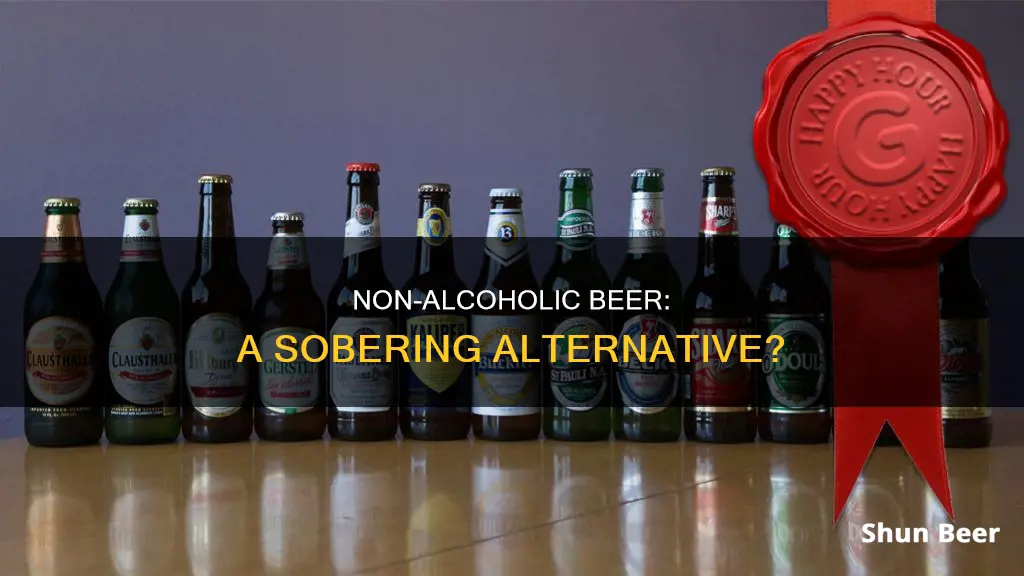
Non-alcoholic beer has gained popularity as a viable alternative for those recovering from alcohol addiction. However, opinions vary on whether consuming non-alcoholic beer is considered breaking sobriety. While some recovering alcoholics find that non-alcoholic drinks help them feel included in social situations without compromising their sobriety, others prefer to avoid any beverage that reminds them of their past struggles with alcohol addiction.
Non-alcoholic beer, also known as NA beer, typically contains very minimal amounts of alcohol, usually less than 0.5% alcohol by volume (ABV). This means that it would take approximately 10 bottles of non-alcoholic beer to equal the alcohol content of one regular beer. While the alcohol content is significantly lower, it is important to note that non-alcoholic beer may still contain trace amounts of alcohol, which could be a concern for individuals with specific medical conditions or those in recovery from alcoholism.
The decision to consume non-alcoholic beer during sobriety is often a personal one, depending on an individual's unique circumstances, triggers, and definition of sobriety. For some, the taste and ritual of drinking beer, even without alcohol, can act as a psychological trigger, potentially leading to cravings for alcoholic beverages. On the other hand, non-alcoholic beer can provide a sense of normalcy and inclusion in social settings, allowing individuals to participate in the ritual of drinking without compromising their sobriety goals.
| Characteristics | Values |
|---|---|
| Alcohol content | Non-alcoholic beer typically contains less than 0.5% alcohol by volume (ABV). However, some products labelled as non-alcoholic may contain up to 0.5% ABV. |
| Health implications | Non-alcoholic beer presents a safer alternative for those avoiding alcohol due to health reasons, as it removes the significant health risks associated with alcohol. |
| Social benefits | Non-alcoholic beer can provide a sense of normalcy and inclusion in social settings, allowing individuals to participate in the social ritual of drinking without compromising their sobriety goals. |
| Psychological impact | For some individuals, the taste, ritual, and social cues associated with drinking beer, even without alcohol, can act as a trigger, potentially leading to cravings for alcoholic beverages. |
| Individual differences | The decision to consume non-alcoholic beer during sobriety is usually a personal choice, depending on factors such as individual triggers, motivations, and support systems. |
| Addiction recovery | Non-alcoholic beer can be a valuable tool for individuals in recovery, helping them navigate social situations and maintain their commitment to sobriety. However, it may also trigger cravings or emotional associations for those with a history of alcohol addiction. |
What You'll Learn
- Non-alcoholic beer may still contain small amounts of alcohol
- It can be a useful tool for social integration, allowing individuals to avoid alcohol without drawing attention to their abstinence in social settings
- It may trigger cravings or emotional associations for individuals with a history of alcohol addiction
- It may be perceived as a slippery slope by some, and a personal decision by others
- It may be considered breaking sobriety, depending on the requirements of specific addiction treatment programs

Non-alcoholic beer may still contain small amounts of alcohol
Non-alcoholic beer is often marketed as a safe alternative to regular beer, but it's important to be aware that it may still contain small amounts of alcohol. In the US, beverages labelled as "non-alcoholic" must contain less than 0.5% alcohol by volume (ABV). This means that you would have to drink 10 non-alcoholic beers to consume the same amount of alcohol as one regular beer. However, research suggests that many non-alcoholic beers contain more alcohol than their labels indicate. One study found that 29% of no- or low-alcohol beers tested had higher alcohol levels than stated on the label, and 6 out of 45 zero-alcohol beers sampled contained more than 1% alcohol.
The presence of alcohol in non-alcoholic beer can have important implications for certain individuals. For example, those with liver impairments may develop higher blood alcohol levels than normal after consuming these beverages, and some people may test positive on alcohol urine or breath tests after drinking them. Additionally, pregnant individuals are advised to avoid all alcohol to prevent fetal alcohol spectrum disorder (FASD), so non-alcoholic beers may pose a risk in this context.
For individuals in recovery from alcohol use disorder, non-alcoholic beer can be a controversial topic. On the one hand, it may serve as a useful tool for social integration, allowing people to avoid alcohol without drawing attention to their abstinence. It can provide a sense of normalcy and inclusion in social settings and help them participate in the ritual of drinking without compromising their sobriety goals. On the other hand, the taste and ritual of drinking beer, even without alcohol, can act as a trigger for some individuals, potentially leading to cravings for alcoholic beverages. The smell of beer, in particular, may serve as a relapse trigger, as it can evoke strong memories of past drinking experiences.
Ultimately, the decision to consume non-alcoholic beer during sobriety is a personal one and depends on various factors, including an individual's reasons for considering it, their definition of sobriety, and their physical and psychological triggers. It is crucial to carefully weigh the potential benefits against the risks to make an informed choice that supports long-term well-being.
Gilgamesh's Drinking Habits: Beer or Something More?
You may want to see also

It can be a useful tool for social integration, allowing individuals to avoid alcohol without drawing attention to their abstinence in social settings
Non-alcoholic beer can be a useful tool for social integration, allowing individuals to avoid alcohol without drawing attention to their abstinence in social settings. It can ease the social pressure and questions about not drinking, helping them to feel included and reducing feelings of isolation.
For some, non-alcoholic beer provides a sense of normalcy and inclusion in social situations where alcohol is present. It allows them to participate in the social ritual of drinking without compromising their sobriety goals. It can be particularly helpful in navigating social situations where alcohol is present, such as social gatherings or dining out, enabling individuals to feel included without feeling pressured to consume alcoholic beverages.
However, it is important to consider the potential psychological impact of non-alcoholic beer. For some individuals, the taste, ritual, smell, and social cues associated with drinking beer, even without alcohol, can act as a trigger, potentially leading to cravings for alcoholic beverages. It is a personal aspect that varies greatly among individuals, especially those in recovery from alcohol addiction.
The decision to consume non-alcoholic beer during sobriety is usually a personal one, depending on an individual's reasons, definition of sobriety, awareness of potential effects, and support network. It is crucial to understand what "non-alcoholic" means, as these beverages can contain up to 0.5% alcohol by volume (ABV) in many countries, which may be enough to necessitate avoidance for some people.
While non-alcoholic beer can provide a sense of normalcy and social inclusion, it is important to be aware of its potential risks and triggers. Each person must carefully evaluate their unique circumstances, triggers, and support system when deciding whether drinking non-alcoholic beer aligns with their definition of sobriety and long-term well-being.
Do Sulfite Wands Really Work for Beer?
You may want to see also

It may trigger cravings or emotional associations for individuals with a history of alcohol addiction
For individuals with a history of alcohol addiction, non-alcoholic beer may trigger cravings or emotional associations. The taste and ritual of drinking beer, even without the alcohol content, can act as a trigger, potentially leading to cravings for alcoholic beverages. The smell of beer, the act of drinking it, or the sound of opening a can may stimulate the reward centres of the brain to release dopamine, triggering a craving for alcoholic drinks.
The psychological impact of drinking non-alcoholic beer is significant. The ritual of drinking beer is often as addictive as the drinking itself. For some, the taste of non-alcoholic beer may trigger "euphoric recall", a selective memory where the positive aspects of drinking are remembered while the negative consequences are forgotten. This can weaken their commitment to sobriety.
However, the impact of non-alcoholic beer varies greatly from person to person. For some, it can provide a sense of normalcy and inclusion in social settings where alcohol is present, allowing them to participate in the social ritual of drinking without compromising their sobriety goals. It can be a useful tool for social integration, helping individuals avoid alcohol without drawing attention to their abstinence.
Ultimately, the decision to consume non-alcoholic beer during recovery is a personal one. It is important to be aware of one's triggers and to consult with healthcare professionals or support groups to determine if non-alcoholic beer is suitable for one's sobriety journey.
Breastfeeding and Alcohol-Free Beer: What's the Verdict?
You may want to see also

It may be perceived as a slippery slope by some, and a personal decision by others
The decision to switch to non-alcoholic beer is a complex and deeply personal one, with varying perspectives among individuals in recovery and sobriety coaches. While some view it as a slippery slope, others consider it a personal choice that does not compromise sobriety. This section will delve into these contrasting viewpoints and explore the nuances of this decision.
The Slippery Slope Perspective
For some individuals in recovery from alcohol addiction, the idea of consuming non-alcoholic beer is akin to treading on thin ice. They perceive it as a slippery slope that could potentially lead back to drinking alcoholic beverages. The rationale behind this concern is the sensory similarities between non-alcoholic and regular beer. The taste, smell, and appearance of non-alcoholic beer might evoke powerful memories of drinking days, triggering cravings and increasing the risk of relapse. This phenomenon is known as "euphoric recall," where individuals selectively remember the enjoyable aspects of drinking while downplaying the negative consequences.
Additionally, the ritualistic aspects of drinking, such as cracking open a can or bottle, can be a trigger for some. The act itself can stimulate the reward centres of the brain, releasing dopamine and creating a sense of anticipation and pleasure. For those who have struggled with alcohol addiction, even these subtle cues can be powerful catalysts for relapse. The availability of non-alcoholic beer might also provide an easy excuse or loophole for individuals who are not fully committed to their sobriety, allowing them to maintain their old drinking habits and environments without addressing the underlying issues.
The Personal Decision Perspective
On the other hand, many individuals view the switch to non-alcoholic beer as a personal decision that aligns with their unique recovery journey. They argue that non-alcoholic beer provides a sense of normalcy and inclusion in social settings where alcohol is present. It allows them to participate in social rituals without compromising their commitment to sobriety. Non-alcoholic beer offers a way to blend in and feel connected without actually consuming alcohol. This perspective recognises the importance of individual agency and acknowledges that what works for one person may not work for another.
Additionally, non-alcoholic beer can serve as a valuable tool for harm reduction. For those who are not ready or willing to embrace complete abstinence, non-alcoholic beer presents a safer alternative. It enables them to moderate their alcohol intake while still enjoying the social and cultural aspects of drinking. This approach can be particularly effective for individuals who are "sober curious" or aiming to reduce the health risks associated with alcohol consumption.
Navigating the Decision
Ultimately, the decision to switch to non-alcoholic beer is deeply personal and depends on an individual's unique circumstances, triggers, and recovery goals. It requires careful self-reflection and an honest assessment of one's relationship with alcohol. Consulting with healthcare professionals, support groups, and sobriety coaches can provide valuable insights and guidance. It is essential to weigh the potential benefits against the risks and make a choice that aligns with one's definition of sobriety and long-term well-being.
Drinking and Driving: Two Beers, Am I Safe?
You may want to see also

It may be considered breaking sobriety, depending on the requirements of specific addiction treatment programs
The decision to consume non-alcoholic beer during recovery from alcohol addiction is a complex and personal one. While non-alcoholic beer can be a valuable tool for social integration, allowing individuals to avoid alcohol without drawing attention to their abstinence, it may also be considered breaking sobriety. This is especially true for specific addiction treatment programs, particularly those in the early stages of recovery, which may have stricter guidelines or complete abstinence expectations.
Addiction treatment programs typically aim to help individuals reclaim control over their lives and improve their physical and mental well-being. To achieve this, such programs often emphasise the importance of avoiding any substances that resemble or are associated with alcohol, including non-alcoholic beer. This is because the taste, smell, and ritual of drinking beer, even without alcohol, can act as a powerful trigger, potentially leading to cravings for alcoholic beverages and increasing the risk of relapse.
The effectiveness of non-alcoholic beer as a tool for recovery seems to depend on the individual. For some, it can provide a sense of normalcy and inclusion in social settings, allowing them to participate in the ritual of drinking without compromising their sobriety goals. However, for others, it may be seen as a slippery slope, blurring the lines between sobriety and intoxication and increasing the risk of relapse.
Ultimately, the decision to consume non-alcoholic beer during recovery depends on the specific requirements of the addiction treatment program and the individual's personal circumstances, triggers, and definition of sobriety. It is crucial for individuals to carefully evaluate the potential risks and benefits of consuming non-alcoholic beer and make a choice that aligns with their recovery goals and long-term well-being.
Beer: Constipation Cure or Myth?
You may want to see also
Frequently asked questions
Non-alcoholic beer has gained popularity as an alternative for those in recovery from alcohol addiction. However, it's important to note that non-alcoholic beer still contains a small amount of alcohol (up to 0.5% ABV). For some individuals, even this minimal amount of alcohol may be enough to trigger cravings or emotional associations related to alcohol consumption. Therefore, it is a personal decision that depends on one's unique circumstances, such as court-mandated sobriety, specific addiction treatment programs, or medical conditions that require complete abstinence.
One risk is that the taste, smell, and ritual of drinking non-alcoholic beer may act as a trigger for individuals in recovery, potentially leading to cravings for alcoholic beverages and increasing the risk of relapse. Additionally, some studies have found that non-alcoholic beers may contain higher levels of alcohol than indicated on their labels, which can be unsafe for pregnant individuals and those with specific medical conditions.
Non-alcoholic beer can provide a sense of normalcy and inclusion in social settings where alcohol is present. It allows individuals to participate in the social ritual of drinking without compromising their sobriety goals. It can also help individuals avoid the pressure and questions that may arise from not drinking in social situations. Additionally, non-alcoholic beer may be a healthier alternative, as it is typically made from natural ingredients and has fewer calories and preservatives than regular beer.







